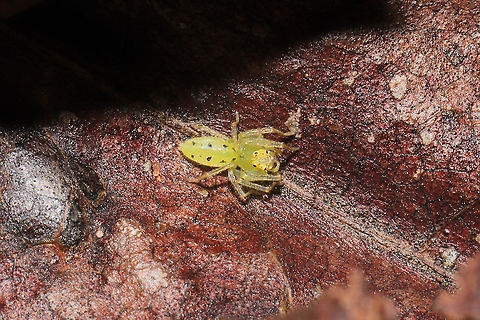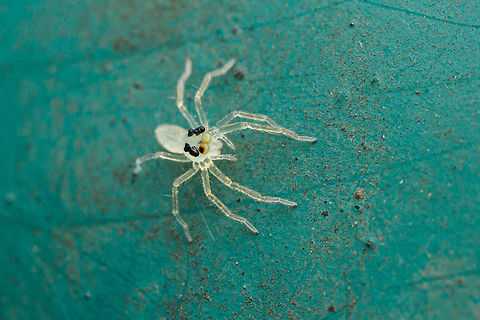
Appearance
The magnolia green jumper is small for a jumping spider, with adult females measuring 7-8mm and adult males 5-6mm. Most specimens appear as a pale, partially translucent green with a small fringe of scales which may appear red, orange, yellow or white on the crown of the head, framing the eyes. "L. viridis" has longer legs, relative to the body, than most jumping spiders, with a smaller leap size. However, "L. viridis" is similar to most other salticids in having highly complex eyes and well-developed vision that is amongst the most acute of all arthropods, as well as complex visual cognition behaviors; the anterior median eyes have the telephoto quality for which jumping spiders are known, but also share features with the eyes of species that evolved earlier than salticids.As with many other Salticidae, male "L. viridis" have brightly-colored and large chelicerae which are used as weapons in contests, and similarly colored forelegs that are waved during visual agonistic displays. The corresponding appendages of females have more muted colors and have significantly lower allometric slopes than those of males. When males encounter each other, they will wave their forelegs and often approach one another until one of them retreats, with a physical fight resulting if neither retreats. During fights, males press their chelicerae and forelegs against each other and push until one tires and retreats.

Habitat
True to its common name, the species often prefers the broad leaves of magnolia trees, particularly in warm, humid forests, but can also be found in dryer climates on oak, maple, pine, and other trees, as well as on bushes lower to the ground. Matings occur in spring months, particularly in May, after which females lay eggs as late as July on the underside of leaves and then guard them until they hatch, with the mothers then dying in August. Sub-adults overwinter on trees and then finish developing in the early spring. Both females and males use both visual and vibratory signals in identifying and communicating with one-another, both in challenges and during mating behavior. Pheromones also play a role in identification."L. viridis" subsists primarily on other species inhabiting plants, including mites, aphids, ants, and occasionally other spiders. Because of its relatively short jump distance, compared to other salticids, "L. viridis" often ambushes its prey, lunging from short distances. Also atypical of salticids, the nests of females are broad and sheetlike and may assist in predation by temporarily immobilizing prey.
References:
Some text fragments are auto parsed from Wikipedia.